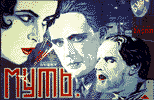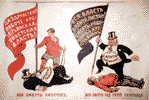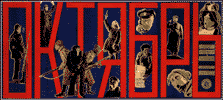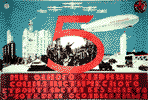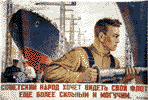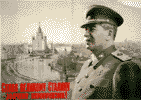|
|
|
 Moor, Dimitri 1st of May - A Festival of Labor |
|
| Collecting Soviet Posters | |
|
Soviet posters are a relatively new area of collecting. Virtually unavailable in the West until perestroika, they were thoroughly researched by Stephen White in his 1988 monograph The Bolshevik Poster. With the decline of communism, there is more interest than ever in the images from this bold social experiment. The mid-1980s saw a steady trickle of images out of Russia, but that trickle has slowed, and many of the highest quality pieces are already unavailable. The works of Rodchenko, Lissitsky and Klutsis can range from $10,000 to $100,000, but many museum caliber pieces from before World War II are available at $300 to $1500. The Bolshevik period is a particularly rich one for collecting. Less expensive, but still fascinating and valuable post-WWII images are also available. [top] |
|
| The Bolshevik Era (1917-1921) [View Posters] | |
|
|
The Bolshevik Revolution created the world's first Communist state. The poster played a key role in selling Lenin’s vision of total cultural and political transformation to a largely illiterate population: it was the centerpiece of the first modern propaganda machine. About 3,600 poster designs were created in roughly three years--more than 20 per week. The new government began by seizing control of the paper supply and all forms of printing. By mid-1918, it began to print and distribute posters. Alexander Apsit, the first great Bolshevik poster artist, developed many distinct Soviet symbols, such as the hammer and sickle and red star. Although his allegorical style was traditional, his imagery reflected the rhetoric of a new age. As Civil War intensified in 1919, the Bolsheviks set up a new Literary-Publishing Department to coordinate propaganda. Its major weapons were Dimitri Moor and Viktor Deni, both cartoonists before the Revolution. Moor was a fervent Communist, whose views had been formed during the unsuccessful Revolution of 1905. By mid-1920, the Bolsheviks had defeated the Whites and reached a stalemate with the Poles. This marked the end of the pioneering era in Bolshevik propaganda. [top] |
| The New Economic Policy (1921-1927) [View Posters] | |
|
|
By 1921, Russia was finally at peace, but the wars had brought almost total economic collapse, famine and bitter discontent. In desperation, Lenin introduced the New Economic Policy (NEP), which allowed some private enterprise to return. Small farms and businesses flourished, while the State kept control of heavy industry, transport and foreign trade. The NEP years were the "Roaring Twenties" of Russia. This relatively free period featured exciting experimentation in all fields. In the arts, the Constructivist movement dominated. Rejecting art for art’s sake, this group wanted to contribute to the "construction" of a new Communist society. The rallying cry "Art into Production" was led by the towering geniuses of El Lissitsky and Alexander Rodchenko. Their work with photomontage, photography, and graphic design had a major impact on the direction of Western graphic arts, particularly the Bauhaus school. State poster production was headed by Yakov Ruklevsky, who recruited a remarkable group of design school graduates. Most famous were the Stenberg brothers, Georgii and Vladimir, whose dynamic images capture the chaotic spirit of the age. Others included Nikolai Prusakov, Iosif Gerasimovich, and the prolific Mikhail Dlugach who created more than 500 posters. [top] |
| The First Five Year Plan (1928-1932) [View Posters] | |
|
|
Upon assuming complete control in 1928, Stalin immediately put an end to the NEP and embarked on a new course to full communism with the Five Year Plan. Intended to turn the USSR rapidly into a powerful industrial nation, it called for vast production increases and massive construction throughout the country. The second aspect of the Plan was the destruction of private farming and the creation of collectives where the peasants worked for the State. After widespread resistance and brutal enforcement, the goals were achieved. By 1933, industry and agriculture were firmly under Stalin's control and the Plan was declared complete six months early. Klutsis and others praised the shock-brigade workers, collective farmers, Young Communists and women workers, demanded contributions for the air fleet or road construction, and stressed the goal of the Plan and a classless socialist society. They attacked the enemies of the State both within and without, always portraying the Soviet Union as the champion of peace and social justice. [top] |
| The Second Five Year Plan (1933-1937) [View Posters] | |
|
|
After this frantic and heroic age, a second Five Year Plan was announced to start immediately. It essentially made up for the shortcomings in the first plan, especially in transport, and even offered some consumer goods, but these were rapidly subordinated to the need to rearm in face of the Nazi menace. More and more a single theme dominated. Literature, art and posters of this period overwhelmingly stressed the role of the infallible leader, Joseph Stalin. His image appeared everywhere, in every context, and always greater than life. The dead hand of conformity, backed by the all-pervading terror, drove out originality and spontaneity, producing the art of Social Realism that dominated the USSR long past the death of Stalin in 1953. [top] |
|
|
"The Great Patriotic War" (1941-1945) [View Posters] The stylistic conformity of Social Realist posters of the late ‘30s ended abruptly with Hitler’s invasion in June 1941. The forces unleashed in the crisis days of the Civil War were reawakened, and Soviet artists again rose to the challenge. Indeed, some of the most powerful icons of the Civil War reappeared. The most famous was Moor’s Have you Enrolled as a Volunteer?, which resurfaced as How have you helped the Front? Mikhail Cheremnykh, creator of the ROSTA Windows during the dark days of the Civil War, issued the first "Tass Window" shortly after the invasion. Tass was the news agency which superseded ROSTA in 1925, and stenciled Tass Windows became a symbol of Soviet resolve throughout the struggle. [top] |
| Post-World War II (1946-Present) [View Posters] | |
|
|
The Post-War period was marked by a return to Social Realism, with Stalin once again becoming the focus of most posters. The High Stalinist Period (1946-1953) revealed images of utopian harmony. Revolutionary fervor returned in the '60s, fanned by the Cold War and the Space Race, and this was reflected in more heroic and satirical images. As perestroika (1984-present) neared, protest became a dominant and powerful poster theme. [top] |
| Copyright 1998 Jim Lapides and Clive Foss |
| PosterShow.com 205 Newbury Street Boston, Massachusetts 02116 |
voice:
(617) 375-0076 fax: (617) 375-0079 email: sales@internationalposter.com |
Copyright 2003 PosterShow.com

